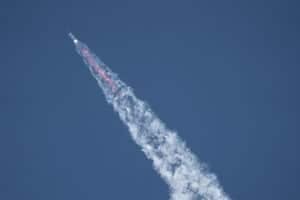The Taurids tend to produce extra fireballs every seven years and the last spectacular display was in 2015.

Earth is passing through a very large, very old meteor stream emanating from the Taurus constellation. And once every seven years, the Taurid meteor shower goes big…
The meteor shower stream – often referred to as the Taurid Swarm – is ancient and peaks roughly every 2 500 to 3 000 years when it passes close to Earth.
The next peak is predicted for the year 3000, however, the Taurid meteor shower also peaks in shorter cycles of seven years, when the swarm passes close by Jupiter.

The 2022 Taurid meteor shower
The meteor shower is known for producing about five meteors per hour.
It’s not the most active meteor shower, but the chance of one of those five meteors being a fireball is extremely high.
Catch a fireball, make a wish
Robert Lunsford from the American Meteor Society said a Taurid fireball is a breathtaking sight to behold because it shines “brighter than any star or planet in the sky”.
“Only the sun and the moon are brighter than the normal fireballs,” he explains.
“They are quite spectacular when you see one.”
An edited version of the lunar eclipse and Taurid fireball picture shot yesterday morning at 6:03am at Hanging Rock Raptor Observatory #LunarEclipse #wvwx pic.twitter.com/Iz3HSMkkIV
— Mark Skaggs (@markskaggs10) November 9, 2022
So, your chances of seeing a fireball tonight are pretty high!
But first, let’s get the pleasantries out of the way; allow us to introduce you to Encke.
Hey there, Comet Encke
Comet Encke – officially known as 2P/Encke – was first discovered in 1786, but was only recognised as a periodic comet in 1819.
It has a diameter of 4.8 kilometres and orbits the sun every 3.3 years. Comet Encke will return to our region of space in October 2023.
WATCH: Taurid fireball caught on dashcam
A Taurid fireball from last night. https://t.co/uiYs3YwHvk
— John Hickey (@JohnWNEP) November 4, 2022
At some point in its past, a fragment (an asteroid known as 2004 TG10) of Comet Encke broke off and is the reason we experience the Taurids every year.
Asteroid 2004 TG10 is large enough to be classified as a ‘near-Earth object’ and a ‘potentially hazardous asteroid’ of the Apollo group.
WATCH: Bright Taurid fireball caught on video
Caught a cool meteor on my webcam in Freeport over Casco Bay. Thursday night, Nov 3rd at 9:14PM. #Meteor #TauridMeteorShower #Taurid @SarahLongWMTW @Todd_Gutner @spann @Met_CindyFitz @NBC10_Mark @ametsoc pic.twitter.com/prZmEDATZ6
— Wonder Pixels (@wonderpixels) November 5, 2022
Seven-year odds of seeing a fireball
The Taurids’ cycle allows for a spectacular fireworks display every seven years when it passes near Jupiter, according to the National Aeronautics and Space Administration (Nasa).
The gas giant’s gravitational pull causes “debris to condense and create a spike in fireballs”, meaning this year’s meteor shower may be more active than usual.
Well I caught at least 1 Taurid fireball last night at Lake DeSmet pic.twitter.com/0pBvaViyW2
— Kevin Palmer (@krp234) November 4, 2022
Nasa explains: “The last time this happened was in 2015, and before then in 2008, creating a seven-year repetition that the meteor society predicted would happen again in 2022”.
How to view the Taurid meteor shower
The constellation Taurus is a V-shaped pattern of stars near the iconic Orion constellation, and is bright enough to see with the naked eye.

Stargazers say you need to “look a little away from the radiant” to see the meteor streaks, and it would be ideal to find a spot far away from overhead lights or light pollution.
You will also need to give your eyes approximately 20 minutes to adjust to the dark. Binoculars or telescopes will enhance your experience but are not required.
And if you miss tonight’s meteor streaks, don’t despair. The Taurid streams are visible throughout November, albeit to a lesser degree.
I told you!
— (RG)OakGill ????????☠️???? (@GillinOakhill) November 9, 2022
A photographer caught this on the east coast.
Called it a Taurid fireball
It happened right at 6:00 a.m. to 6:02 a.m. at the height of the eclipse.
I said I saw a huge blue lightsaber shoot across the sky!
Thank God someone caught it!
TOLD Y’ALL!!
????????????????????️ pic.twitter.com/T1vuirNNQi
The next meteor shower (known as the Leonids) will peak on Thursday, 17 November, and is predicted to put on quite a show as well.
ALSO READ: Massive ‘planet killer’ asteroid discovered near Earth, hiding in sun’s glare






